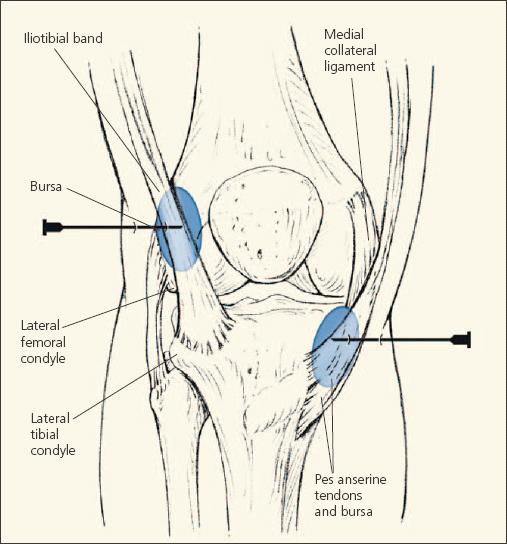

May have pain with resisted internal rotation, resisted flexion, and valgus stress (especially in athletes).Exostosis (a benign outgrowth of cartilaginous tissue on a bone) of the tibia may contribute to chronic symptoms in athletes.Crepitus over the bursa occasionally present.Bursa usually not palpable unless effusion and thickening present.Tenderness over the proximal medial tibia at the insertion of the pes anserine, approximately 2 to 5 cm distal to the anteromedial joint line.Bilateral symptoms in one third of patients.May have coexistent medial collateral ligament pathology (tenderness superior and posterior to the pes bursa).More common in sports requiring side-to-side movements and cutting.May have chronic, refractory pain in setting of arthritis or obesity.Worse on ascending and possibly, descending stairs and when rising from a seated position typically deny pain with walking on level surfaces.Pain, tenderness, and localized swelling over the medial knee.Acute trauma to the medial knee, athletic overuse, chronic mechanical (pes planus) process or degenerative process.

Therapy consists in rest and appropriate therapeutic and physiotherapeutic treatments. In most cases, tendinopathy is provoked by continual mechanical stress, causing repeated microtraumas. Symptoms consist in strong pain and burning sensation underneath and inside the knee, where pes anserine tendons insert. This pathology occurs mainly to long-distance runners, young athletes (because of their premature beginning of the sports practice), and especially in women. In fact they provoke excessive friction on the common tendon insertion and underlying bursa that may cause overload work for these muscles and lead to inflammation. Overweight, biomechanical overburden, and improper posture could predispose to this pathology. Pes anserine tendinopathy can hit sartorius, gracilis, and semitendinosis muscle tendons in their insertion area.


 0 kommentar(er)
0 kommentar(er)
